Back to Don's Maps
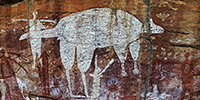 Back to Australian rock art and other Oz sites
Back to Australian rock art and other Oz sites Sandy Creek Aboriginal Rock Art Site, near Laura, Northern Queensland
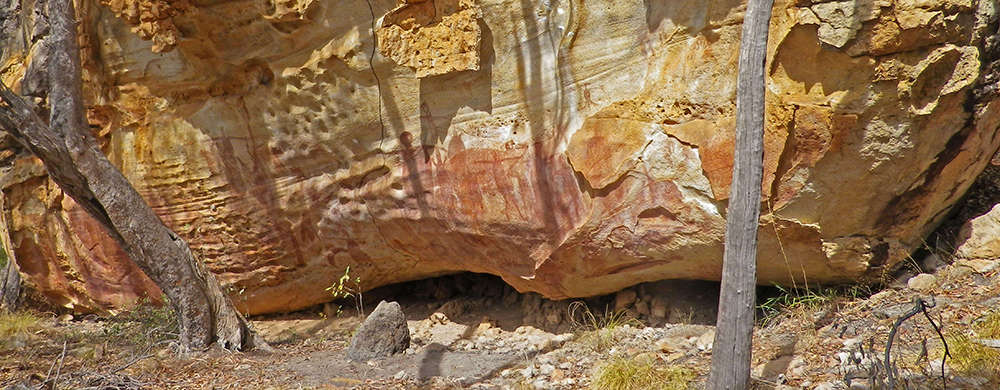
Sandy Creek Aboriginal Rock Art Site, near Laura, Northern Queensland
Photo: © Leo Dubal
The excellent photographs of Sandy Creek Aboriginal Rock Art Site on this page are from Leo Dubal, www.archaeometry.org
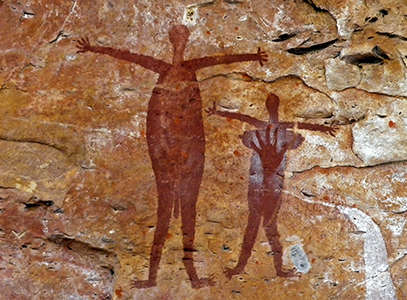
Painting in red haematite of a man and a woman. Many Australian Aboriginal paintings show the breasts of women spread to indicate their gender, in this case with nipples. The man's penis is shown.
This particular pose of humans, face on, with arms and fingers spread wide, is a common feature on this rock shelter.
Photo: © Leo Dubal
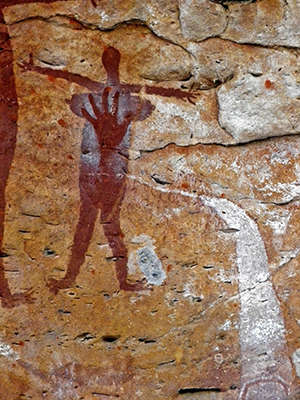
It should be noted that in both these particular cases, the arms are shown joined to the neck, that is, the shoulders are not shown, and the body is rounded and featureless.
The bodies are infilled uniformly, and five fingers are shown on three of the hands, with the right hand of the woman only showing four.
A later hand stencil using white ochre has been placed over the female's chest and abdomen.
Photo: © Leo Dubal
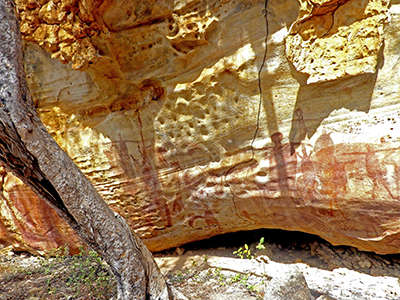
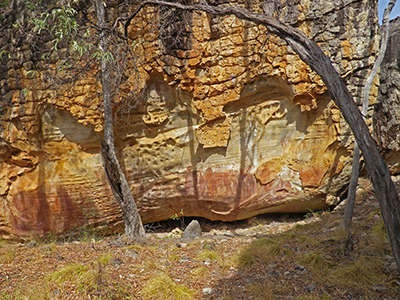
General photographs of the rock shelter.
Photo: © Leo Dubal
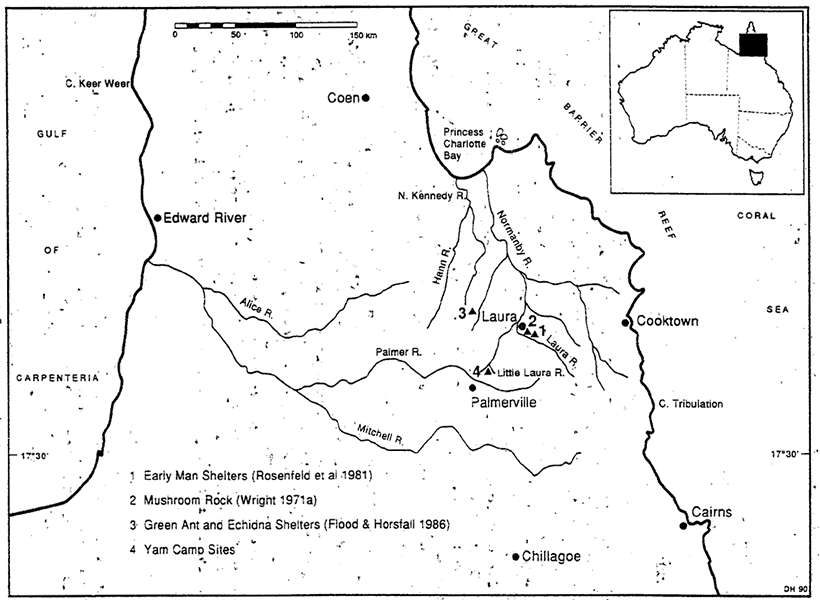
Map of part of Far North Queensland showing the location of the Laura River rock art sites.
Photo: Pearson (1989)
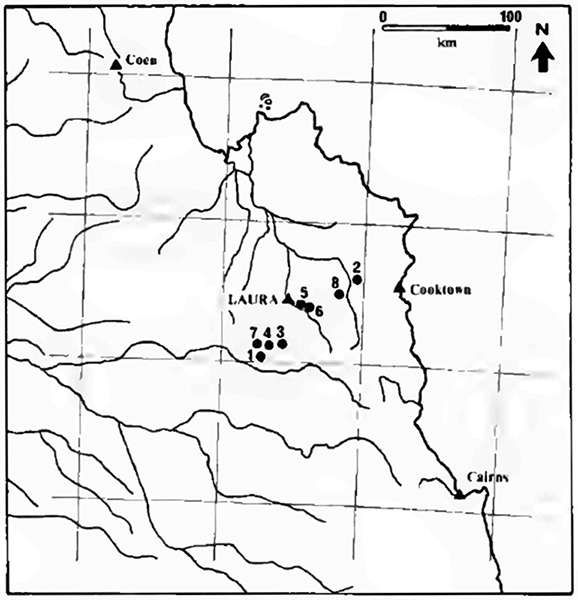
The Laura sandstone belt, showing the location
of some rock art sites.
1 Yam Camp
2 Platform Gallery
3 Magnificent Gallery
4 Sandy Creek
5 Mushroom Rock
6 Early Man
7 Red Bluff
8 Red Horse
Photo and text: David and Chant (1995)
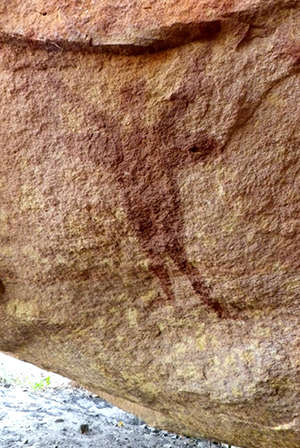
Apparently an old image of a woman, judging by its condition. The woman is shown with exaggerated breasts spread wide, and arms raised.
Photo: © Leo Dubal
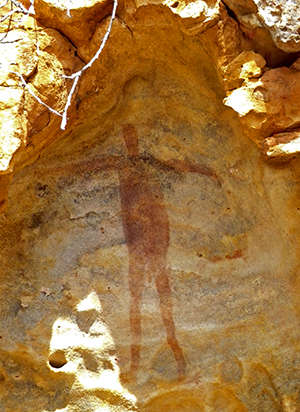
This image of a man with penis shown, is quite naturalistic, with good proportions. The shoulders are shown, but fingers were either never painted or have disappeared with time.
One knee is bent, and the arms are held at right angles to the body.
The painting is in an eroded niche in the wall of the shelter, and is well suited to the space it is in.
Photo: © Leo Dubal
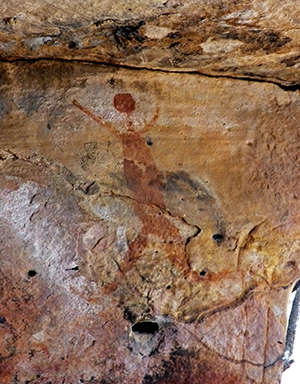
This particular figure is shown running, in contrast to most of the humans who are shown standing at attention.
Photo: © Leo Dubal
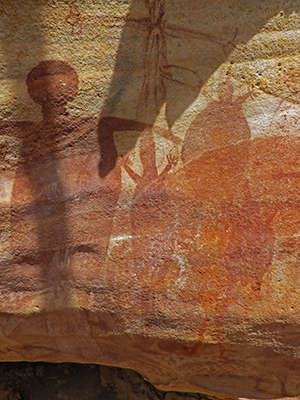
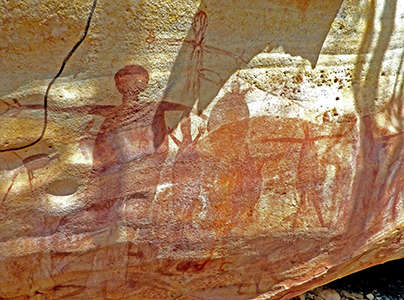
This is part of what might be thought of as the main panel at the rock shelter.
It is complex, with many overlapping images. On the left is a man with stocky body and round head, with other men shown less prominently or painted over. Below his left arm is what might be a goanna, with what appears to be a flightless (or at least very heavy) bird of some kind on his right.
Above him is a figure lightly sketched in with several strokes, not infilled with a solid colour.
Photo: © Leo Dubal
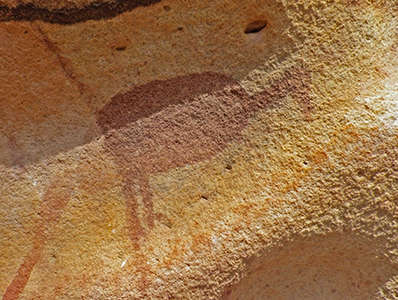
Closeup of the heavy bird.
Photo: © Leo Dubal
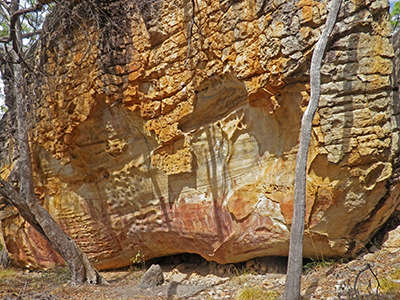
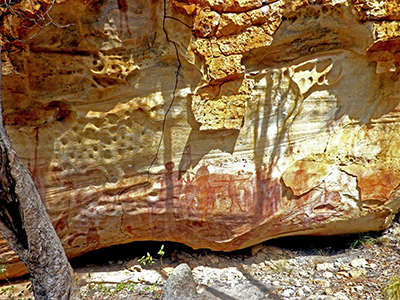
General photographs of the rock shelter.
Photo: © Leo Dubal
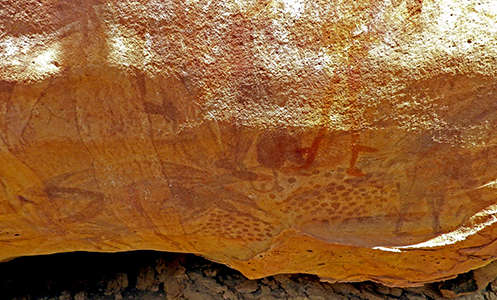
The main figure in this image is what appears to be a very thick set man outlined, with thick arms and the outline infilled with many strokes, perhaps denoting hair.
Looking to the right of the figure, we can see many red haematite dots in two separate groups. In addition, above and between these dots, is a symbol that may represent a vulva.
One indistinct figure on the right of the image appears to have projections from its knees, but the top part of the image is badly faded.
Photo: © Leo Dubal
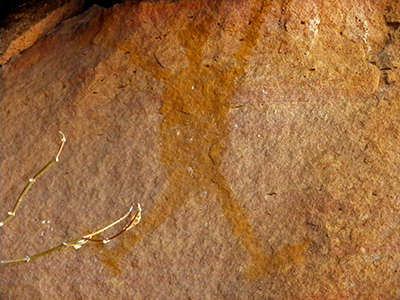
This may not represent an ordinary human.
The head has a pronounced neck, with the head not a complete circle.
The legs are widespread, and the arms are raised above the head.
The figure appears to have either very large feet, or shoes which project both forward and backward.
Photo: © Leo Dubal
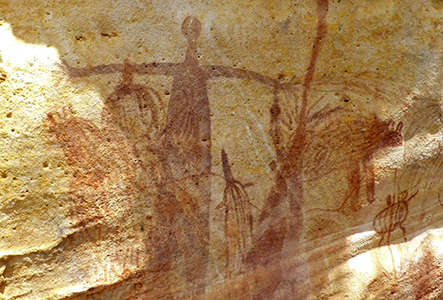
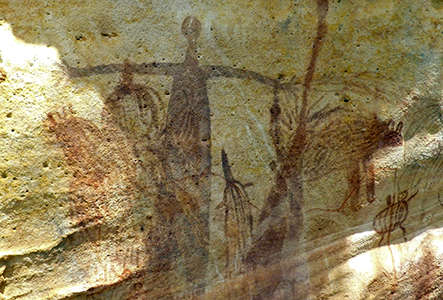
(left) natural colour image, (right) false colour image to increase contrast.
This appears to be a man surrounded with jellyfish. On the right is a four footed hairy animal with a rounded body and ears shown.
Photo: © Leo Dubal
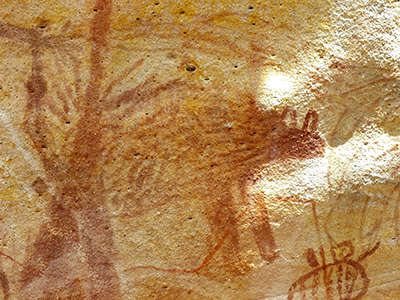
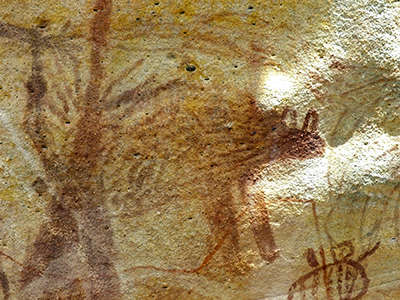
(left) natural colour image, (right) false colour image to increase contrast.
The animal is possibly a possum.
Photo: © Leo Dubal
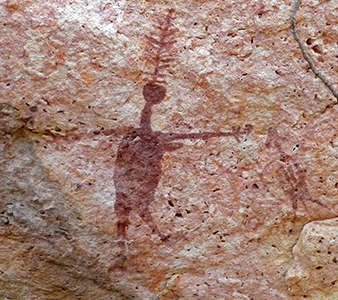
Female dancer, with an elaborate headdress. Only one breast is shown.
On the right of the image is a quinkan figure, with the characteristic head shape, thought by some to represent a mushroom, while others see the shape a denoting very large ears.
Photo: © Leo Dubal
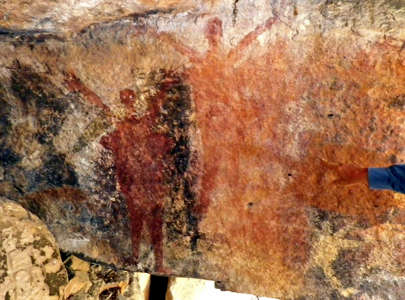
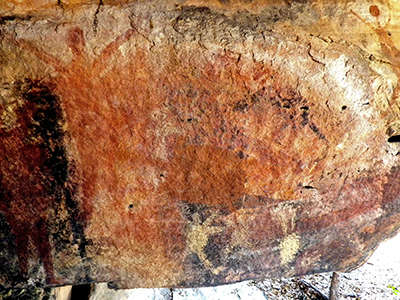
An area with multiple images overlaying one another, but a woman and a man with arms raised can be distinguished, completed using haematite or red ochre.
There is another image which is difficult to decipher in brown ochre, pointed to by Leo Dubal, of a sub-rectangular shape with an attached 'tail'.
Photo: © Leo Dubal


To the right of the figures above, and smaller, a dancing figure in white ochre, possibly female, and a positive hand print, formed by dipping the hand in white ochre, and pressing the hand on the surface.
Photo: © Leo Dubal
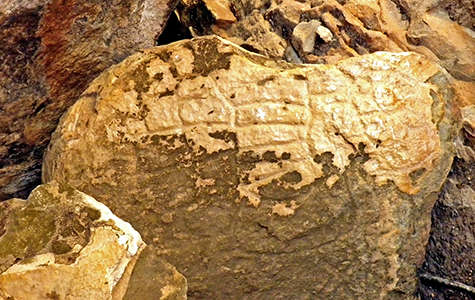
Beside the panel above can be found a separate rock with sub-rectangular grooves in the sandstone, with a whitish patina, possibly natural, over much of it.
Photo: © Leo Dubal
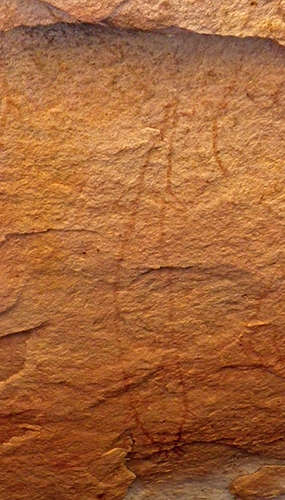

These images are of the Freshwater Sawfish, found in fresh water streams along the northern coast of Australia.
Photo: © Leo Dubal
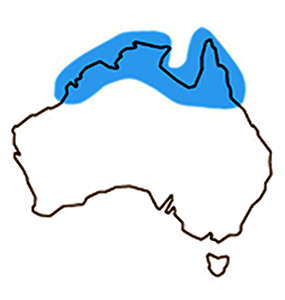
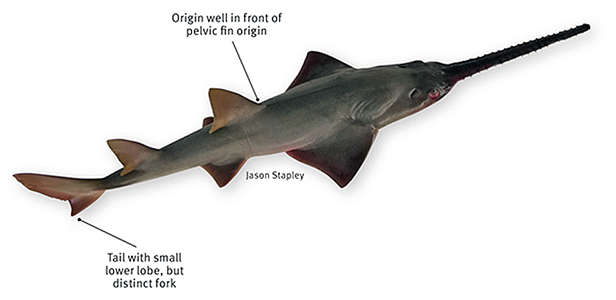
Pristis microdon
The freshwater sawfish has a distinct fork in its tail fin, which also has a small lower lobe. The origin of the first dorsal fin is well in front of the pelvic fin origin.
A large ray-like fish with distinctly saw -like snout, usually with 18 teeth on each side. Brown -olive dorsally, white underneath. Relatively uncommon, found in coastal drainages in northern Australia, sometimes a long way upstream in freshwater creeks.
Common length 150 cm, maximum length 600 cm.
Photo and text: http://www.daff.qld.gov.au/fisheries/species-identification/shark-identification-guide/photo-guide-to-sharks/sharks,-part-3/freshwater-sawfish
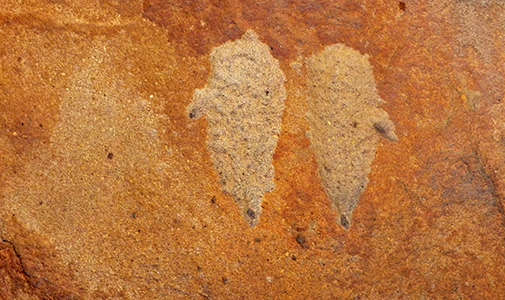
This is a superbly executed, pecked engraving of macropod tracks. They are possibly of the Eastern Grey Kangaroo (see below). Note the very careful symmetry of these two images pecked into the patina of the sandstone.
Photo: © Leo Dubal

This is a summary of the engraving types from an extensive Panaramitee style site with over 20 000 individual engraved motifs in Western New South Wales.
The researcher identified variability within a motif class (the macropod track) and investigated possible causes for that variability.
In this case, the tracks above fit the Eastern Grey Kangaroo, the first pair of tracks, labelled C, in the second column of this illustration.
Photo: McDonald (1993)
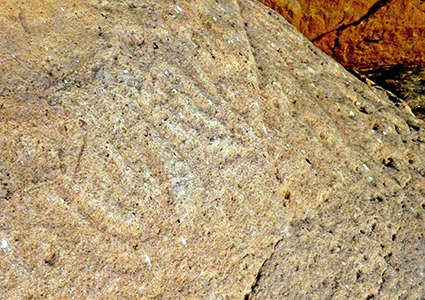
Ancient engravings with a meaning now lost. The engravings follow a somewhat meandering course across the face of the rock.
Photo: © Leo Dubal
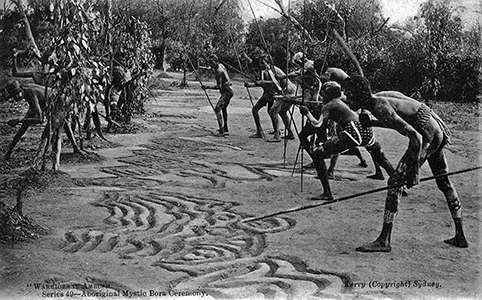
This image shows the way that engravings of parallel curved lines were important parts of some Aboriginal ceremonies.
Date ca. 1900-1927
Source http://www.acmssearch.sl.nsw.gov.au/search/itemDetailPaged.cgi?itemID=75764 (item)
http://www.acmssearch.sl.nsw.gov.au/search/itemDetailPaged.cgi?itemID=71625 (collection)
Photo: Kerry & Co.
Warriors in Ambush : series 49 - Aboriginal Mystic Bora Ceremony
Broadhurst collection of postcards of New South Wales scenes
Permission: This image may be used freely without requesting permission. The State Library of New South Wales requests acknowledgement that the image is from the collections of the State Library of NSW.
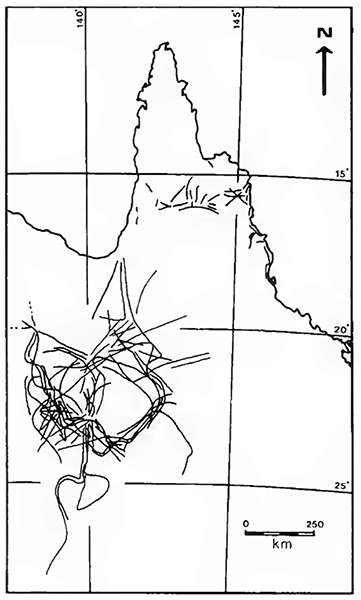
trade diagram from Roth, compiled from various publications from 1897 to 1910.
Photo and text: David and Chant (1995)

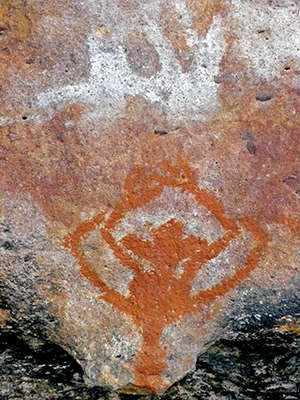
At first sight this looks like a spirit figure of some kind, but it bears some resemblance to a fresh water crayfish, especially with the orientation of what may be arms and claws.
Photo: © Leo Dubal

Cherax quadricarinatus, an example of an Australian fresh water crayfish.
Photo: Riek (1951)

Dingo.
A mustard coloured ochre has been used for this image.
Photo: © Leo Dubal
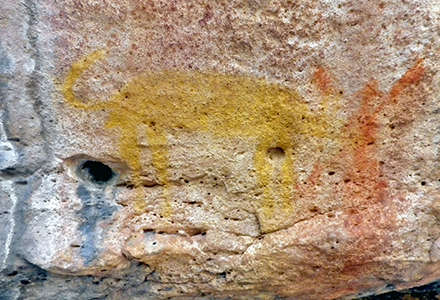
Dingo completed in yellow ochre.
Photo: © Leo Dubal
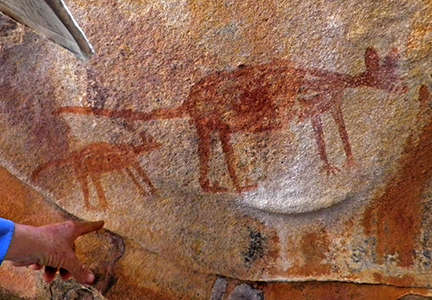
Dingo and pup.
Photo: © Leo Dubal
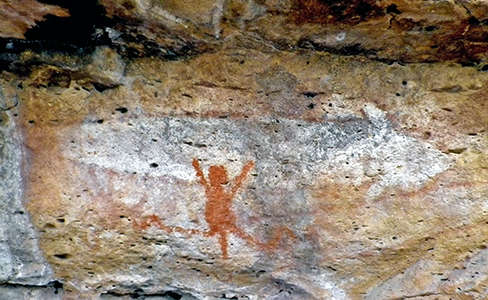
Male spirit figure with exaggerated penis, and long legs which project sideways in a sinuous fashion.
Photo: © Leo Dubal
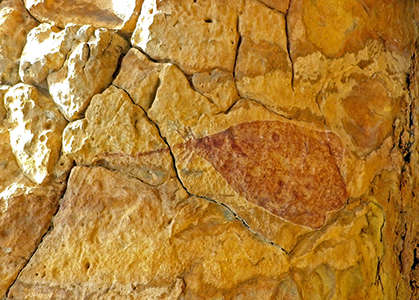
Yam figure. This was a style for paintings at one time, so that every depiction, no matter on what subject, was based on the shape of a yam.
Photo: © Leo Dubal
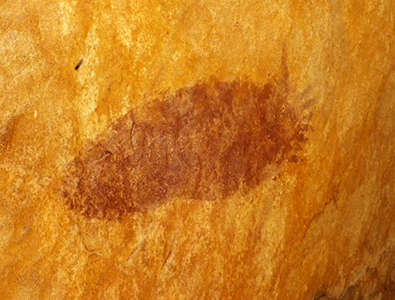
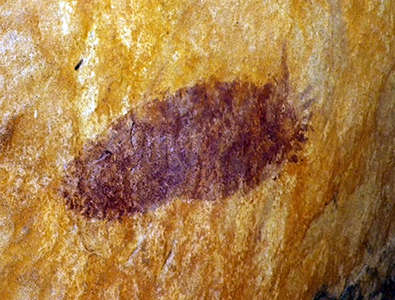
Yam figure, shown in false colour in the right hand image to increase contrast.
Photo: © Leo Dubal
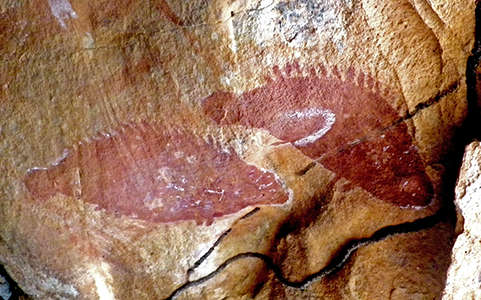
Burramundi are often depicted in rock art, as here.
Photo: © Leo Dubal
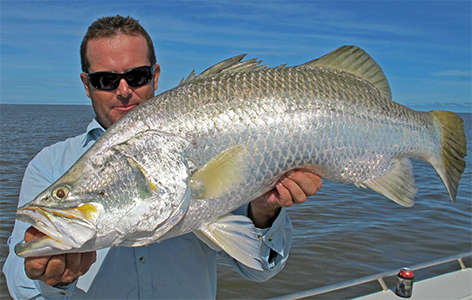
Burramundi, surely one of the most desirable eating fish in the world.
Photo: http://www.ntfishing.com.au/881/barramundi-run-off-fishing-shady-camp/img_0121/#!prettyPhoto

These appear to be stick figures of some kind.
Photo: © Leo Dubal
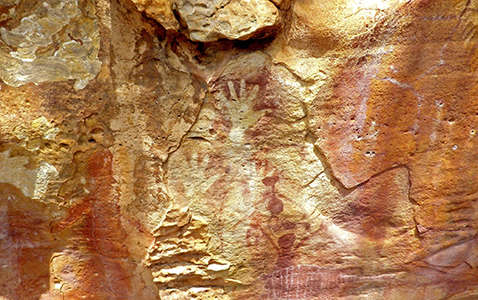
Hand stencils done in red ochre, and paintings of spirit figures, somewhat ant like in outline.
Photo: © Leo Dubal
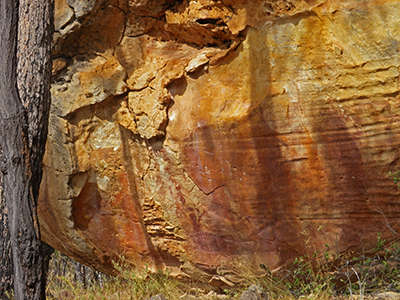
General photograph of the rock shelter.
Photo: © Leo Dubal

Map of some of the sites mentioned.
Photo: supplied by Leo Dubal
Edge-ground axes in Pleistocene Greater Australia: new evidence from S.E. Cape York Peninsula
Morwood and Trezise (1989)
Recent archaeological research in S.E. Cape Tork peninsula indicates that edge-ground axes were in use in this region of north Australia before 32 000 BP.
Edge-grinding is one of the hallmarks of the Neolithic in Europe but the evidence now suggests that it may have been part of the technological repertoire of the earliest Aboriginal colonists in some areas of Australia-New Guinea.
This paper discusses some of the implications of edge-ground artefact distribution and chronology in the region. In the l960s, an excavation. was undertaken by P. J. Trezise at Sandy Creek 1, a large sandstone rockshelter on the head of Sandy Creek, tributary to the Little Laura River near the township of Laura, S. E. Cape York Peninsula. The excavation removed the uppermost, artefact-rich deposits in the shelter to an average depth of 75 cm to expose panels of partially-buried, pecked engravings at the rear of the shelter. In addition, a trench 8 feet long by 6 feet in width was excavated from the rear wall to the dripline.

The distribution and chronology of edge-ground axes in greater Australia.
Photo and text: Morwood and Trezise (1989)

The east (outer) baulk of the deep trench excavated at Sandy Creek 1 in the 1960's. This drawing was made by Eddy Oribin, an architect, using a grid of 1 foot squares. It shows the position of the edge-ground axe on bedrock, as well as the stratigraphy of the deposits.
Photo and text: Morwood and Trezise (1989)
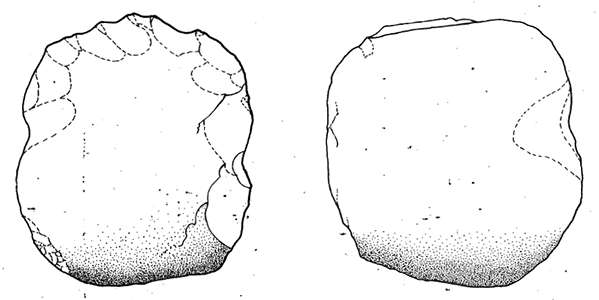
The edge-ground axe recovered from the base of the 1960s excavation at Sandy Creek 1. It is of pink quartzite and has a maximum length of 87 mm. The implement is both waisted and grooved to facilitate hafting.
Photo and text: Morwood and Trezise (1989)
Sandy Creek
M. H. Monroe
http://austhrutime.com/sandy_creek_shelter.htm
Sandy Creek Shelter 1
This cave is in the Laura region of Cape York, Queensland. The occupation sequences here go back 32 000 years. Buried rock engravings and many stone tools, including a ground-edge axe on the bedrock at the base of the 3 m sequence. The evidence from this site of Pleistocene age and in nearby Sandy Creek Shelter 2
The earliest evidence of occupation at this site was a stone-knapping floor of 26 small artefacts of crystalline quartz near the base of the rubble. It was associated with charcoal dating to 32 000 BP. Above this level there are few artefacts until the occupation around 18 000 years ago.
The most important artefact from this site is the ground-edge axe. It was pink quartzite, 8.7 cm long, with a ground working edge, a slight waist and groove for hafting. it is very similar to ground-edge axes from Arnhem Land.
Buried petroglyphs are present at this occupation site, on the back wall of the shelter was a pecked panel, made up of pecked straight and radiating lines, curves, bird tracks and pits, part of which was 75 cm below the ground level of the occupation sediments. Later a sandstone fragment that is believed to have fallen from the frieze on the rear wall, was found that had pecked engraving. It was dated to 14 400 years ago, setting a minimum age for the site. Some believe they are of the Panaramitee tradition. The thick desert varnish as well as a high degree of patination, suggest the petroglyphs may be very old, possibly as old as the 32 000 year old occupation they appear to be associated with. This is further evidence of the possible great ago of the Panaramitee style.
A sandstone fragment, on which there is part of an unidentifiable engraved motif, has been dated to 12 620 ± 370 BP (Beta 51089), calibrated minimum age of 14 400 BP. The fragment is believed to have fallen from a part of the wall where there are a number of engraved discs, pits, curved lines and bird tracks. Sections of the walls show signs of exfoliation.
Sandy Creek Shelter 2
Dates from 3 haematite layers from between layers of an oxalate crust have been obtained. These results are believed to document painting events at 6 655 ± 80 BP, 15 000 - 16 000 BP and 24 600 ± 220 BP. No visible motifs were present.
Sandy Creek Shelter 1
David and Chant 1995
Sandy Creek 1 is a sandstone rock shelter located to the southwest of Laura. Like Yam Camp. It was excavated by Morwood in 1989. Morwood and Trezise reported that an excavation was undertaken at the site by P. Trezise in the 1960s, removing 'the uppermost, artefact-rich deposits in the shelter to an average depth of 75cm to expose panels of partially-buried, pecked engravings at the rear of the shelter. In addition, a trench 8 feet long by 6 feet in width was excavated from the rear wall to the dripline.
This work was executed with little stratigraphic control and remains unpublished except for Morwood's recent documentation of these events. Morwood re-excavated Sandy Creek 1 for two main reasons. Firstly, the peckings at the site were reminiscent of those at Early Man, dated to the late Pleistocene, and secondly, Trezise claimed to have found an edge-ground axe at the bottom of the deposits. If the apparent age of the engravings was any indication, the base of the deposits was likely to be of considerable antiquity, and thus Trezise' s findings may indicate the presence of very old axes in southeast Cape York Peninsula.
This opened up the possibility that the axes were comparable in age to Pleistocene axes found in Arnhem Land, and thus may be evidence that the two regions were linked by a more or less unified information exchange network during early times. Excavations at the site by Morwood were thus aimed at investigating the older deposits.
Six stratigraphic layers and two main sedimentary units are identified, with a near-basal date of 31 900± 700. Morwood and Trezise reported:
... there are two main sedimentary units at the site, a sand sheet approximately 175cm deep and an underlying concreted sandstone rubble which extends to a bedrock of deeply-weathered white sandstone at a depth of 265cm ... Both the sand sheet and the rubble are colluvial, derived from coarse stratified sandstones which occur on a higher ridge behind the shelter.
Within the sand sheet is an upper grey layer some 60cm deep which contains a high density ofstone artefacts, ochre and charcoal.
Seed grindstones, microblades, backed blades, and burren adze slugs are restricted to this grey sand. Below this is an orange sand, which is generally lower in artefact, ochre and charcoal density, but exhibits definite occupational horizons corresponding to periods of apparent shelter use and abandonment. The earliest of these begins just above the rubble at a depth of 140-175 cm.
Radiocarbon dates and stratigraphic diagrams presented in a later paper place the antiquity of the basal rubble layer from shortly before 32 000 BP to shortly after 8 320 ± 120 BP, after which sandy sediments appear. The upper, culturally rich grey sand layer begins sometime between radiocarbon dates of 1 890 ± 70 BP and 1 230 ± ;50 BP, indicating a similar temporal trend to that documented from Yam Camp. Morwood has not yet presented results to further define these trends, but it is significant to note that the documented changes cannot solely be explained by changes in sediment depositional regimes, as the major period of sedimentary change - from coarse rubble to sand - begins around 8 000 BP. It is not until some 6 000 - 7 000 years after the major changes in depositional regimes take place that the main cultural changes are documented.
Sandy deposits are present through most of the Holocene, but it is not until the late Holocene that the major technological and typological innovations, as well as significant increases in the deposition rates of cultural materials, take place. The implications of these findings are that the documented cultural changes were not solely caused by taphonomic factors. They further suggest that the changes cannot readily be explained by exclusive reference to environmental alterations.
References
- David B., Chant D., 1995: Rock art and regionalisation in north Queensland prehistory, Memoirs of the Queensland Museum, Brisbane 1 August 1995 Volume 37 Part 2 Hamlyn-Harris, Ronald; Queensland Museum
- McDonald J., 1993: The Depiction of Species in Macropod Track Engravings at an Aboriginal Art Site in Western New South Wales, Records of the Australian Museum , (1993) Supplement 17. ISBN 0 7310 0280 6
- Morwood M., Trezise P., 1989: Edge ground axes in Pleistocene Greater Australia: New evidence from S.E. Cape York Peninsula, Queensland Archaeological Research, Vol 6 (1989)
- Pearson W., 1989: A Technological Analysis of Stone Artefacts from Yam Camp Surface Scatter and Rockshelter, S.E- Cape York Peninsula, Queensland Archaeological Research, Vol. 6, December 1989
- Riek E., 1951: The freshwater crayfish (family Parastacidae) of Queensland, Records of the Australian Museum, 22(4): 368–388. [30 June 1951]. doi:10.3853/j.0067-1975.22.1951.615 ISSN 0067-1975 Published by the Australian Museum, Sydney
Back to Don's Maps